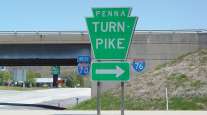Staff Reporter
Trucking Groups Not Pleased With Toll Hikes in Northeast States

[Stay on top of transportation news: Get TTNews in your inbox.]
Toll increases this year in Pennsylvania, New Jersey and New York are frustrating trucking companies that are having to pass on costs in the form of higher freight charges.
“In the past, toll increases were years apart, but now agencies pass multiyear increases to reduce the number of times they must deal with the toll payers,” said Gail Toth, executive director of New Jersey Motor Truck Association. “Trucking companies just pass along the increase.”
According to the Port Authority of New York and New Jersey (PANYNJ), automatic inflation-based adjustments (triggered by a 14% jump last year in the consumer price index) led to $1 increases in auto tolls at tunnels and bridges. New fees for trucks vary from $57 to $69 for three axles, $76 to $92 for four axles, $95 to $115 for five axles and $114 to $138 for six axles.
“Tolls on the Atlantic City Expressway are charged on a per-axle basis,” said spokesperson Kimberly Testa. “As of Jan. 1, 2023, toll rates were subject to 3% indexing.”
The highest South Jersey Transportation Authority tolls are charged at Egg Harbor and Route 50 (Exit 17): $8.87 to $9.85 for three axles, $11.97 to $13.30 for four axles, $14.85 to $16.50 for five axles and $17.73 to $19.70 for six axles.

Drivers travel on the New Jersey Turnpike and connecting roads in Elizabeth, N.J. (Ted Shaffrey/Associated Press)
Toth noted that rising regional tolls have become common for the past decade. “The most frustrating thing is that more and more tolls collected by agencies have been used for mass transit. The argument is that if they improved our mass transit there would be less congestion on the roadways. We don’t have a problem paying to maintain the toll roads we use but we shouldn’t be using toll dollars for other projects,” she remarked.
Kendra Hems, president of the Trucking Association of New York, addressed the impact of the PANYNJ toll increases on members.
“I’m sure it has hit them, but those that operate in the city just incorporate it into the cost of doing business and likely try and recover it through their freight rates when possible,” she said, noting that the toll increase ties into trucking associations’ concerns about the proposed congestion tolling in New York City.

Vehicles at the Lincoln Tunnel, where new toll gantries were installed in November of 2021. (PANYNJ via Flickr)
“Trucks are already paying between $87 and $115 to cross into [New York City]. There was one scenario in the congestion pricing proposal that would hit trucks with an additional $82 toll to cross into the central business district. We are seeking a full exemption for commercial vehicles, or, at the least, the ability to credit their bridge and tunnel crossings against the congestion pricing toll,” Hems said.
The Pennsylvania Turnpike, which receives no tax appropriations to maintain or operate its roadway, raised tolls 5% this year to help fund capital improvement obligations.
Rebecca Oyler, president and CEO of Pennsylvania Motor Truck Association, noted, “Obviously, the costs for commercial vehicles to traverse the PA Turnpike are a huge concern for PMTA members. No one likes to drive on the most expensive toll road in the world. The costs paid by trucking companies driving the turnpike in Pennsylvania contribute to making the state uncompetitive for trucking businesses and make goods more expensive for everyone.”
Oyler said rising turnpike tolls are no surprise since from the passage of Act 44 of 2007 through last year, the turnpike commission has turned over $450 million every year to PennDOT to fund the state’s transit systems.
“The result is a $13.2 billion debt obligation that keeps tolls high and ensures that increases will keep coming for the foreseeable future,” she said. “Overall, PMTA believes the lesson to be learned from the PA Turnpike is to beware of diversions of highway funds intended for roads.”

Host Seth Clevenger speaks with Torc Robotics CEO Peter Vaughan Schmidt about the realities of autonomous truck technology and how they fit into the freight transportation industry. Hear the program above and at RoadSigns.TTNews.com.
Second of a three-part series on autonomous vehicles. Hear Part I here. Part III coming Feb. 2.
Turnpike officials are interested in hearing from truckers. “We have begun to regularly survey our commercial trucking customers to better understand their needs and concerns,” said Rosanne Placey, turnpike manager of communications and marketing. “And while truckers do share a concern about the cost of our tolls, they typically caveat that by saying that the savings in time and fuel in using our roadway does offset those concerns.”
Toll rates last year for a five-axle commercial vehicle (represented by weight Class 6) were about 52 cents per mile for E-ZPass and $1.06 per mile for video transactions for a through-trip on the Pennsylvania Turnpike Mainline, according to a July 2022 toll revenue investor relations document.
Oyler said, “The trucking industry has no problem paying its fair share for the roads and bridges it uses every day, but when the taxes we pay aren’t spent to maintain those roads, but are instead diverted to other projects, the disconnect leads to problems like — in this case — runaway tolls that have no connection to the service the users are paying for. It should be a lesson policymakers take to heart as we discuss transportation funding models in the future.”
Want more news? Listen to today's daily briefing below or go here for more info:


